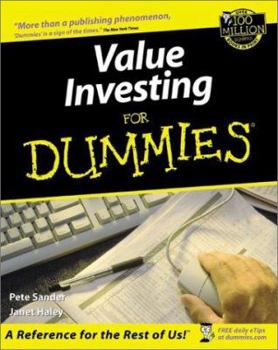Value Investing for Dummies?
Select Format
Select Condition 
Book Overview
Want to follow in Warren Buffett's investing footprints? Value Investing For Dummies, 2nd Edition, explains what value investing is and how to incorporate it into your overall investment strategy. It... This description may be from another edition of this product.
Format:Paperback
Language:English
ISBN:0764554107
ISBN13:9780764554100
Release Date:January 2002
Publisher:For Dummies
Length:384 Pages
Weight:0.90 lbs.
Dimensions:0.9" x 7.4" x 9.2"
Customer Reviews
3 ratings
Comprehensive value investing book
Published by RJ , 10 months ago
After retirement I've re-read my 40+ investment books and this one is most comprehensive on Intrinsic Value investing followed by Ben Graham and Warren Buffett. Some math, but only exponentials.
Value Investing for Dummies
Published by Thriftbooks.com User , 19 years ago
It is a good book for beginners in the subject of value investing. It is quite comprehensive but a bit long-winded at times. The only problem I find is that, for practical purposes, it stated that either you create your own intrinsic value model using Excel/Lotus spreadsheet or use the prepackaged Web model - the Quicken Stock Analyzer. However, to use the Quicken Stock Analyzer, you need to be a member. To get a Quicken.com Member ID, you need a current version of Quicken 2001, 2002, 2003 or 2004. When you install and register your copy of Quicken, you can specify your desired Quicken.com Member ID at that time. If you, a beginner, does not use Quicken software or does not know how to input the given formula into the Excel worksheet - tough. Another way is to read a more difficult book by A. Damodaran on value investing. Other than the above, the book is a good introduction and the first book to be read on value investing.
Nothing Better--For Beginners
Published by Thriftbooks.com User , 21 years ago
After reading many books on Warren Buffett and, more broadly, on the subject of value investing, I still found myself a bit lacking in how to identify the true worth of a business. The reason for this was that many of the books assumed more than, in fact, I really knew.(This is not to say that such books were of no value to me or won't be for you. It is simply stating the obvious: without a solid grounding in how to evaluate, and quantify, what any of the businesses I looked at were worth, I was strongly limited in my efforts of making good investment decisions. I was able to tell, for instance, that a company was competently run but not whether it would earn enough in the future to justify its current price. And that, as every rational investor will tell you, is key to achieving investment success.)_Value Investing for Dummies_ assumed virtually nothing. Sure enough this meant much in the book was a review of what I had already learned from others (and might be for you too) but to my mind there's nothing wrong with relearning what is already known. (Better to do so with a book at least than with one's own money.) In assuming little-to-nothing of the reader, the authors give the reader all the tools he or she needs to invest profitably in the future. Crucial to the dummy reader and, in this case, that means me, the book shows how to understand the _language_ of business: accounting. Since this is where the book shines, I'll pause here to allow the authors themselves a chance to explain what it is they're setting out to do. In Part 2 of the book titled "Fundamentals for Fundamentalists" the authors state their intentions as follows:"We open the value investor toolbox by first engaging in a short exploration of investing mathematics . . . Next up is a discussion of information and information sources key to the value investor. Then, we dig in further with a tour of the financial statement landscape, including balance sheets, income statements, and cash flow statements. Ratios and ratio analysis are explored as a way to make more sense of these numbers. Finally, we help you to find and interpret non-numeric influences in the value equation."In the next section, Part 3, the authors again state their intentions:"We help you to assess or _appraise_ the value of a company and relate that value to the stock price. We examine some of the proven methods of business value asessment, including intrinsic value, book value, discounted cash flow, and the strategic profit formula. Then we sprinkle in a dash of intangibles (investors shouldn't live by numbers alone) and discuss buy and sell decisions. To bring these tools and techniques together into a system, we use none other than the full example of the master, Warren Buffett. Finally, to provide practice and reinforcement we present case studies of value, and for further reinforcement we resort to the age-old technique of showing opposites: examples of _un_value."As a reader of the book, and now a reviewer,





